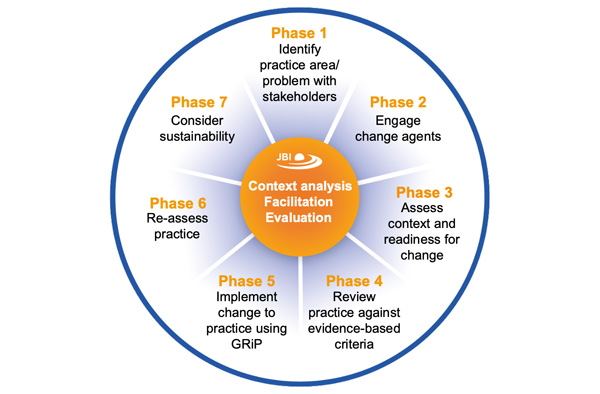
The JBI Approach in Evidence Implementation
Pragmatic flexibility
The landscape of evidence implementation in healthcare is a complex mosaic, woven with theories, models, and frameworks. The JBI framework for evidence implementation stands out as a pragmatic beacon, a process model that integrates theories to steer the implementation of evidence into practice. Its strength lies in flexibility, capable of accommodating various frameworks without enforcing a single theory.
Moullin et al.'s recommendations align with the JBI approach, emphasising the stages of implementation processes, albeit with a broader scope. The distinction lies in granularity; the JBI method is tailored explicitly for real-world evidence implementation, unlike the more generic nature of these recommendations.
Peters et al.'s classification unveils the JBI approach's ideal terrain—implementation efforts seeking adequacy and plausibility. This method finds resonance in designs like before-and-after studies, participatory action research, and comparative non-randomised studies. Its application spans diverse designs, from action research to quality improvement studies, showcasing its adaptability.
However, amidst the surge in theory application, concerns arise. Some theories stagnate without evolving through empirical research, risking becoming scripted explanations for complex social phenomena. Critics advocate for simplicity, emphasizing empirical evidence over excessive theoretical frameworks.
Yet, theory remains an essential compass in the dark alleys of implementation science. While the abundance of theories might stem from academic incentives, grounding work in theory avoids stumbling blindly through quality improvement studies or complex interventions. A clear rationale for theory selection is crucial, preventing mere lip service to frameworks.
The JBI approach, backed by over 20 years of practice, shines as a proof of concept. Over 560 documented implementation projects attest to its efficacy, showcasing tangible shifts in healthcare practices across various settings globally.

In the tapestry of implementation science, the JBI approach stands not as a rigid doctrine but a complementary guide. It bridges the gap between theory and practice, providing structure while seamlessly integrating with existing frameworks. It serves as a practical vehicle for theory-informed evidence implementation, offering a navigational compass in the intricate realm of healthcare advancements.
Read more in the discussion paper published in the December 2023 issue of JBI Evidence Implementation:
Munn, Zachary; McArthur, Alexa; Klugar, Miloslav; Stannard, Daphne; Cooper, Adam S.; Enuameh, Yeetey; Porritt, Kylie
JBI Evidence Implementation. 21(4):386-393, December 2023.
Related resources:
Porritt, Kylie; McArthur, Alexa; Lockwood, Craig; Munn, Zachary
JBI Evidence Implementation 21(1):p 3-13, March 2023. | DOI: 10.1097/XEB.0000000000000361